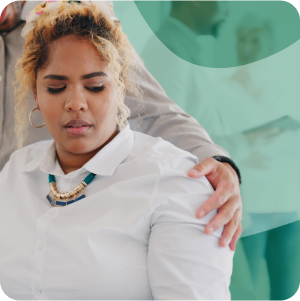
Insights to Action: What Good Aged Care Training Looks Like
Picture this: you’re at etrainu’s booth at the 2025 Ageing Australia National Conference. Something catches your eye. A white, vintage rotary telephone, a striking contrast to the vivid jade-green banner in the background. Next to it sits an iPad, prompting you to answer one simple question:
What does good aged care training mean to you?
The responses were overwhelming. Better yet, the insights we gathered—from carers, leaders, advocates, and more—revealed the thoughts of those on the frontline supporting older Australians, and what they think good training should look like.
Across the responses, these clear themes emerged:
- Older people need to be viewed as just that: people, not conditions or pathologies
- Compassion and collaboration are essential
- Holistic, engaging, and practical training are vital
Here’s what we heard.
1. Person-centred
"Aged care training is so important because we need to understand the people who are needing care. We need to understand their requirements, their background, their cultural beliefs, and we need to do it with diversity and inclusion, and with respect and dignity.
Training for aged care carers, for workers, for managers, and for leadership teams, in terms of how we best support people coming through the system, especially with the new reform, I think, is very important.
Short and sharp is really good, but also really diving into the actual demographic of who we’re looking after, I think, is the most important of all."
- Chloe
The core themes people spoke about were delivering training rooted in empathy, dignity, and respect. These sentiments highlighted the changes set to come to the sector, particularly with the strengthened Aged Care Quality Standards, which place the person receiving care at the centre of everything.
It also further highlighted the importance of caring for people, not their conditions, i.e. not just focusing on completing tasks but ensuring the person is comfortable, which means upholding and respecting their rights and caring for them with compassion.
What came through very clearly was the personal connections carers made to their own families. They spoke of wanting the same assurances that their own loved ones would be adequately looked after, and they felt it was important that training should ensure carers are aware of their expectations in delivering high-quality care.
Hence, a person-centred approach is a must when it comes to training.
2. Accessible, inclusive, and engaging
Good training meets carers where they are. Most of the time, carers are time-poor and have varying levels of proficiency in English (for some, this is their second or third language), as well as digital literacy.
So, effective training must be easy enough for everyone to use and accessible on a variety of devices, including phones, tablets, and computers, etc. That way, they can complete their training at a time and place that suits their needs.
“I would say it should be simple enough for people who are not very digitally literate and easy for people with English as a second or third language.
Nothing that is too long that takes them off the floor. And I'd love something engaging for them that they remember and want to go back to.”
- Allison
Beyond accessibility, training should be fun! With carers being on the go, they want to learn in a way that is engaging and interactive, so they can retain what they’ve learnt.
Whether through scenarios, short videos, activities, knowledge checks, and interactive design, the goal of any online aged care training should be to help carers gain skills and apply them to their delivery of care.
3. Practical
Online training should never be a substitute for practical, in-person training. However, it’s essential that online training yields practical outcomes for carers to take away.
Training should help carers understand what they can expect in their day-to-day roles and responsibilities. For example, demonstrating how carers can exactly meet the needs of the people receiving their care.
Beyond that, the need for practical outcomes ensures that carers can receive measurable training and proof that they are aligned with the needs and requirements of their roles and those they support. In other words, the training should result in competent carers who follow standard, consistent practices.
Additionally, the training should also reinforce the reason why carers provide support in the first place and why they undergo the training: to ensure that the clients receive quality care and feel respected and empowered.
Final thoughts
Person-centred, accessible, engaging, practical, and compliance-driven: that’s what the voices of aged care professionals have said makes good online training. It’s not just about ticking boxes; it’s about ensuring that older people can live their lives with dignity and respect.




